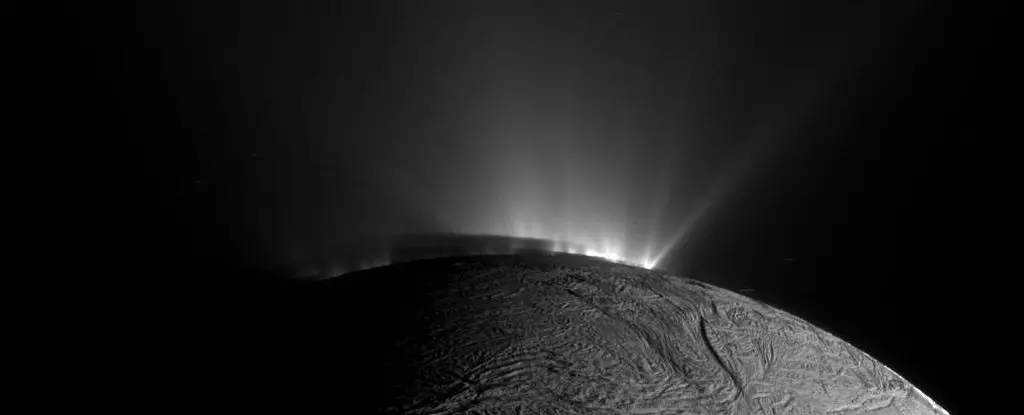As one of Saturn’s many moons, Enceladus may seem inconspicuous and visually unimpressive. Standing in the shadows of Saturn’s magnificent rings and the enigmatic hexagon-shaped storm, Enceladus often goes unnoticed. However, appearances can be deceiving. Recent analysis of data captured by the Saturn Cassini probe has revealed a remarkable discovery – Enceladus is brimming with a vast array of organic molecules. These findings have sparked excitement in the scientific community and reignited discussions about the potential for extraterrestrial life. In this article, we delve into the fascinating world of Enceladus, exploring the evidence that suggests the presence of a habitable subsurface ocean and the tantalizing possibility of microbial communities thriving within its depths.
Enceladus remained a enigmatic enigma until the Cassini mission’s arrival in 2004. As Cassini explored Saturn and its moons, it unexpectedly stumbled upon plumes of mist erupting from the cracks in Enceladus’ icy shell. This surprising finding confirmed the presence of a liquid ocean hidden beneath its frozen exterior. Subsequent analysis of data collected by Cassini’s Ion and Neutral Mass Spectrometer (INMS) instrument detected the existence of organic molecules within these plumes, including water, carbon dioxide, methane, ammonia, and molecular hydrogen. However, the INMS instrument’s low mass resolution presented difficulties in identifying the less abundant species accurately.
A new analysis conducted by a team led by astrobiologist Jonah Peter from Harvard University and the NASA Jet Propulsion Laboratory has shed further light on Enceladus’s chemical composition. Using statistical modeling and comparing the data to a library of known mass spectra, Peter and his colleagues identified a broader range of organic molecules than previously known. Among the additional compounds discovered were hydrogen cyanide, acetylene, and propylene – all of which play critical roles in prebiotic chemistry, the chemistry that leads to the formation of life.
One of the most intriguing aspects of Enceladus is its potential to harbor a hospitable subsurface ocean. The moon’s active hydrothermal environment, fueled by its tidal interactions with Saturn’s gravitational forces, provides an intriguing possibility. These interactions result in a phenomenon known as tidal heating, causing the stretching and compressing of Enceladus, which generates thermal energy that seeps through vents on the ocean floor. This energy could theoretically create a habitable environment, similar to Earth’s deep oceans, where life could thrive despite being far from the Sun’s warmth.
While the presence of organic molecules and the existence of a subsurface ocean are undoubtedly exciting, it is crucial to exercise caution when interpreting these findings. Discovering organic molecules on a celestial body does not prove the existence of life; it merely implies the conditions necessary for life may be present. Enceladus could be hosting a wealth of molecules by chance, rather than due to biological processes. To determine whether life truly exists on Enceladus, further exploration and investigation are necessary.
The findings from the analysis of Enceladus have intensified the fervor surrounding potential missions to this enigmatic moon. While a dedicated mission to Enceladus is still in the proposal stage, each piece of evidence discovered brings us closer to unlocking the secrets Enceladus holds. Laboratory experiments conducted on Earth can help narrow down the possibilities and shed light on the habitability of Enceladus. However, to unequivocally confirm the existence of extraterrestrial life, we must venture beyond our planet and explore the mysteries of Enceladus firsthand.
Considering the rich, diverse chemical environment identified on Enceladus, there is a possibility that complex organic synthesis and the origin of life could occur within its subsurface ocean. The tantalizing prospect of discovering life beyond Earth awaits us. To move forward, funding, planning, and collaboration must align to send a mission specifically designed to probe the secrets of Enceladus.
Enceladus, the unassuming moon of Saturn, holds a wealth of secrets just waiting to be unraveled. The discovery of an abundance of organic molecules, along with the presence of a subsurface ocean, has ignited excitement within the scientific community. While we cannot definitively conclude the existence of extraterrestrial life on Enceladus, the possibility remains tantalizingly real. Each milestone we reach brings us closer to uncovering the truth behind this distant world, fueling our curiosity and inspiring us to continue our pursuit of knowledge. The journey to Enceladus serves as a reminder that in the vastness of the cosmos, hidden wonders lie waiting to be explored – awaiting our courage to embark on yet another daring quest for knowledge and discovery.



Leave a Reply